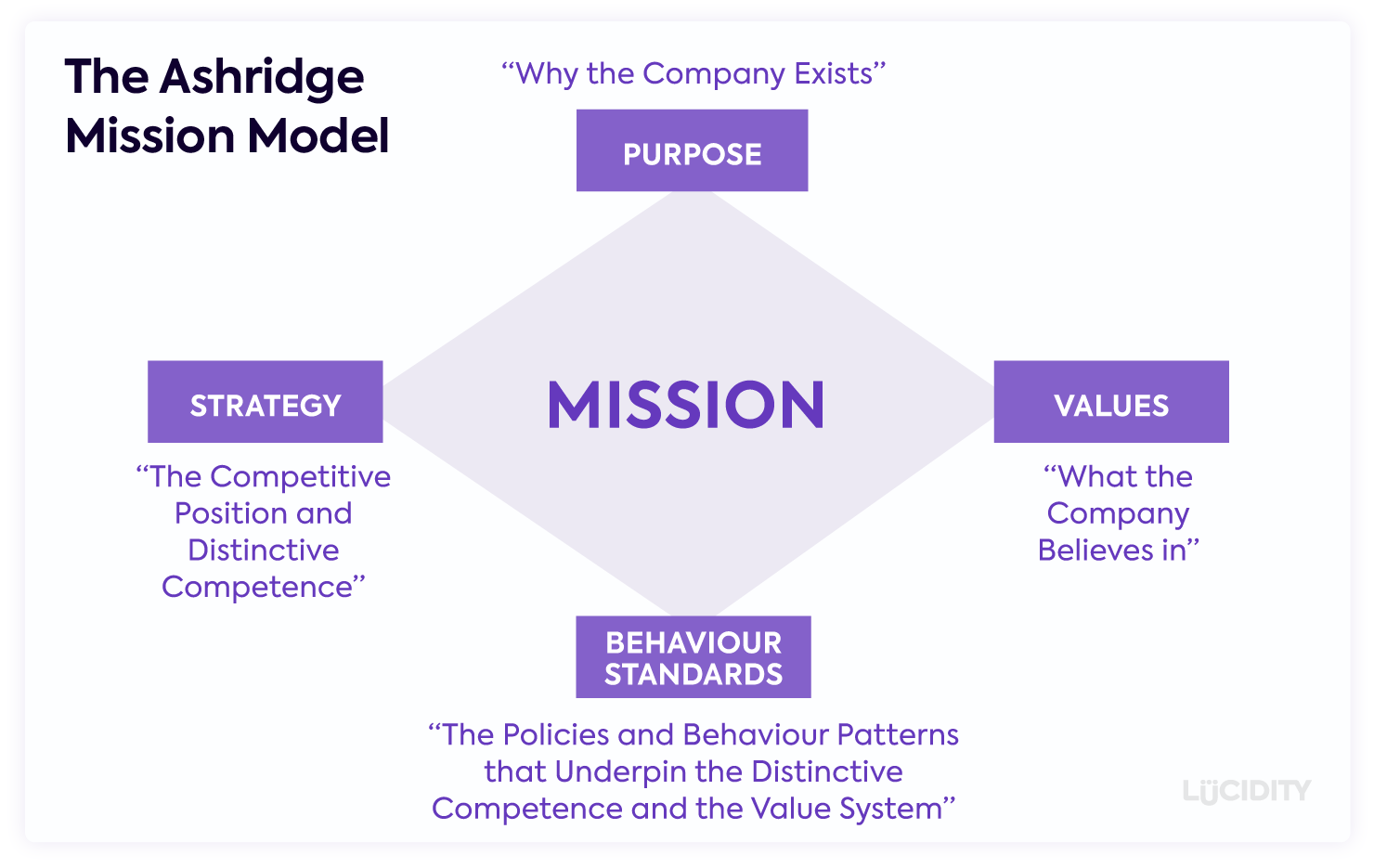A good mission contains your key objectives and how you intend to get there. A mission statement summarises this in a short, engaging way. It’s a statement of why you exist and what you do, but often your mission statement is easier said than… well, said in a short, engaging manner.
Developing a good mission statement can take time and can be a difficult process. Thankfully there are many resources out there to help, from examples to guides, and even frameworks. This article looks at the latter.
What is the Ashridge Mission Model?
The Ashridge Mission Model is a framework designed to define what a mission is and thus help companies create it. This in turn leads to it being easier to develop your mission statement.
It’s a piece of work that was devised over a 24-month period looking at over 50 successful companies. The model focuses on the four important aspects:
- Purpose
- Strategy
- Values
- Behavioural Standards
The first two focus on the tangible aspects of the business, whereas the last two are fibres of the overall culture of the company. The mission binds these four aspects together to go from the purpose through to the execution behaviours.
What is Purpose in the Ashridge Mission Model?
The purpose of the company is the reason it exists. Beyond generating value for the shareholders, it heavily links to the concept of your vision statement. The defining statement which declares how the world will be and enables all employees to understand what the company is trying to achieve.
Mission Purpose Questions:
- Is the mission supporting the vision/purpose?
- Is it inspiring, engaging and interesting for the team?
- Will people get behind it and support it?
Helpful Links:
What is Strategy in the Ashridge Mission Model?
The Strategy is the way the company is going to get from A to B. It defines how it’ll beat the competition and lays out the pathway to growth and success. Strategy is vital as it provides a way to ensure everyone is on the same page, focused on the right activities.
Mission Purpose Questions:
- Does the mission reflect the strategic plan or objectives?
- Is the current position or desired position referred to in the mission?
Helpful Links:
What are Values in the Ashridge Mission Model?
Company values underpin the behaviours and beliefs that are embedded into a company culture. You’ll have heard of many common ones, such as Integrity or Honesty or Teamwork, and hopefully your company with have their own unique spins on the common values. For successful companies there’s a strong relationship and similarity between the company values and the personal values of each employee.
Mission Values Questions:
- Is the statement something that the team will be proud of?
- Does the mission support or refer to the values?
Helpful Links:
What are Behavioural Standards in the Ashridge Mission Model?
Behavioural Standards or Norms are the real world implementation of your values. Refer to the list of values you have in the company, and consider how to they influence your behaviour?
Behavioural Standards can take many forms, from high level concepts such as having a positive attitude when dealing with customers, through to being more specific around the process followed when certain activities are requested by customers.
Mission Statement Behavioural Standard Questions:
- Is the mission supported by the behavioural standards?
- Does the mission reflect the behaviour standards?
Helpful Links:
What are the advantages of the Ashridge Mission Model?
This model has a number of advantages:
- It provides structure to quite a difficult task
- It ensures the mission statement produced is fit for purpose
- It links the concept of Values/Behaviours with Strategy/Vision
- It’s a good team task to go through and discuss
What are the limitations of the Ashridge Mission Model?
The limitations of the model include:
- It’s a time consuming process to do all at once so lends itself better in situations where elements such as Company Values are already defined
- A lot of the finesse that takes place on mission statements is highly subjective and so requires balancing to ensure everyone is on board and positive
What other activities help with the Ashridge Mission Model?
There are a number of activities that can help you with this model:
- Defining your company values
- Analyzing your industry
- Creating a vision statement
- Creating your mission statement
Who invented the Ashridge Mission Model?
This model was developed at the Ashridge Strategic Management Centre following a 2 year research period. Leading this work were Andrew Campbell and Sally Yeung, publishing their findings in a paper called “Creating a sense of mission” back in 1991.
Why was the Ashridge Mission Model invented?
Campell and Yeung both felt that the whole area of mission was misunderstood at best and neglected at worst, so set out to build a model that would help companies develop excellent missions. In doing this, they both felt research suggested companies would be more successful with an aligned and committed team.













